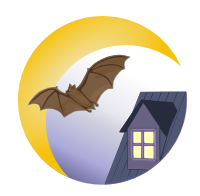Living in a maternity colony facilitates successful reproduction. Preserving them is important, but sometimes cohabitation with bats can be difficult. Maternity colonies must not be disturbed during the breeding period (June-August). If disturbed, young bats who are unable to fly could become trapped and possibly die. Preventing bats from forming a colony in your house is best done either in April or May, before pups are born, or after the females have left the colony for their wintering sites in September or October.
If it is absolutely necessary to remove the bats, you can do it yourself by following the steps below:
1st step: Finding the openings
This step should be carried out during the summer. In order to remove a colony, you must locate the openings to the colony and block them. Sometimes, the most frequently used openings can be identified by blackish stains of guano that surround them. Watch the house at dusk and locate the area(s) the bats come out of. It may be helpful to carry out steps 1 to 4 from the following protocol. You can also take advantage of this search for openings to count the bats, which will give you an idea of the maternity colony’s size. If possible, carry out these checks on several consecutive nights in order to find all the spots by which the bats move in and out of the maternity colony.
2nd step: Blocking the openings
In October, when bats begin their migration, you can start blocking the entrances with a silicone sealant, steel wool, mortar, a screen, etc. During construction work, you must plug all the openings used by the bats and any openings that are at least 2 cm wide. Leave one or two holes open in order to ensure that any bats still inside can escape.
3rd step: Blocking the final holes
Fasten a screen or a polypropylene anti-bird net in front of these final openings. Attach the upper portion and the sides of the screen/net with staples or small nails. Let the lower portion fall in front of the opening, but do not fasten it. This step will allow the last bats left in the building to come out, but they will no longer be able to get back in. Later on, around the end of October, you will be able to permanently block off these last openings. For further information, you can visit the following link:
4th step: Installing a bat house
Bats are very loyal to their maternity colony site. They will most likely return the following spring and try to gain access to their former site, which is why it is very important to plug all the holes correctly. In this case, you can supply the bats with an alternative roost site. Set bat houses as high up as possible so that the bats are protected from predators. Ideally, position them near the main openings of their former site. The quantity and dimensions of the bat houses will depend on the size of the maternity colony. Setting up several bat houses will maximize the chances that bats will inhabit them. For more information, consult the "Setting up a bat house" section.
A new tool to understand how to intervene effectively
To learn more about the recommendations to follow to remove a colony safely depending on the time of year, consult the Guide to safe removal of bats from buildings

